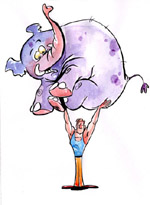Francesca Rossi from Italy contacted us and asked how best to teach can/can’t/is able to. Here are some suggestions.

Can means is able to, as well as is permitted to.
e.g. I can speak Japanese. / You can smoke in the café.
Meaning: make sure you focus on one meaning and don’t muddle them up.
Context: choose a clear context to introduce the meaning.
Pictures
Pictures are very good for presenting grammar. For can/able to find a picture like this (draw one on the board, or find an appropriate picture in a magazine):

Find a second picture – a weedy man struggling to lift a chair:

Elicit other sentences from the students. Give them prompts if they do not have enough language to think of their own sentences like:
- pick up a table
- fight a crocodile
- break a door
Students make sentences like:
Mike can break a door. Will can’t fight a crocodile.
To ensure meaning is clear make examples about the students from facts you know:
Ask questions that require only yes or no answers, so students can concentrate on meaning:
- Can I pick up an elephant?
- Can Johnny speak Japanese?
- Can Maria cook paella? etc.
Using real examples from the class will ensure that they are meaningful for students. If you add some very silly ones, you will get the attention of students and they may be motivated to add their own examples.
Concentrate on allowing students to hear the target language. Later they can see the written form, but now they should be digesting the meaning through the context and teacher's questions.




No comments yet